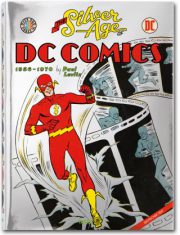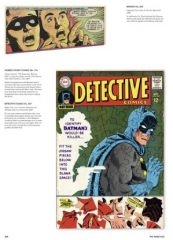If this is your first book of Taschen’s DC chronicles of the comic ages you may feel comfortably transported back in time. To the years between 1956 and 1970 to be exact, when after some stagnation in the Super Hero “business” new impulses started a fresh age.
 And with another BANG! this hardcover book continues Taschen’s story of DC Comics, started recently.
And with another BANG! this hardcover book continues Taschen’s story of DC Comics, started recently.
As with all the books from this series, Paul Levitz wrote the many captions, essays and commented on the cover details. He has worked for DC Comics for 35 years as writer, organizer and lately president. Only recently, in 2010 he started writing again, among other things for the Legion stories.
This volume comes with a long interview of legendary artist Neal Adams, inventor of Green Arrow, Green Lantern and basically responsible for the shift to a more mature image of Batman.
He also has a reputation for drawing some of the best war comics (like Our Army at War and Star Spangled War Stories).
Furthermore, Adams produced features for Marvel Comics, and later founded his own company Continuity Comics.
In conversation with Paul Levitz, he unveils many important details (if you are a comic buff), and many interesting facts (if you aren’t) about the way DC Comics influenced popular culture in the comic silver age.
One of the many distinct changes typical for that era of comic book publishing at DC was a shift towards the detailed, large pages, often resembling advertisements. And actually, some comic artists spent some years doing exactly this as some sort of extra training.
The Silver Age was facing several problems, most had to do with the Comics Code Authority and the restrictions following.
From 1954 onwards the publishers were more or less forced to self-regulate the content of their stories, and now horrific content, violence, gore and the displays of sexual intimacy were prohibited.
Neither were policemen, government officials, judges and the like to be presented as villains nor be disrespected. And in the end, good had to triumph over evil, hence killers, bank robbers and other villains simply had to be brought to justice (e.g. the police).
DC Comics followed the code as long as 2011.
Another important detail of the age is the resurrection or modification of some of the greatest DC Super Heroes like the Flash. The character of Jay Garrick, being the first Flash (or the Crimson Comet) appeared from 1940 – 1949.
Then in 1956 the reinvention (or reincarnation) of the Flash took place, and Barry Allen, a police chemist and scientist, was invented who became the new Flash with a slightly different red outfit. This rebirth actually started the Silver Age of DC Comics.
The book also devotes a long passage to Batman, his reinvention, the Batman movies, merchandise and caricatures, plus a short overview on rather little-known comics like Teen Titans, Sugar and Spike, Superman’s Pal Jimmy Olsen, Girls’ Love Stories, and Heart Throbs.
Since this is the second installment in Taschen’s DC series, there will be more ages to cover, continuing the series in late 2014 with the Bronze Age, and the Dark Age as well as the New Age to be published after that.
Until then…. enjoy the hundreds of sketches, original covers, details, censored drawings and film stills. (This review is of the edition in German, there are also editions in English and French).
Review by Dr. A. Ebert (c) 2014
Paul Levitz. The Silver Age of DC Comics. Taschen, 2013, 400 p. ISBN 978-3-8365-3577-9


